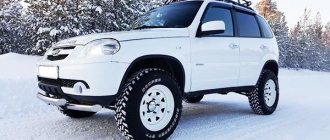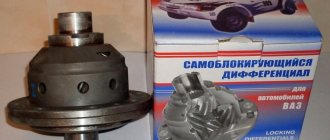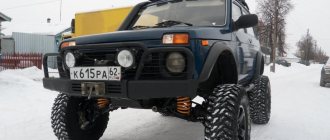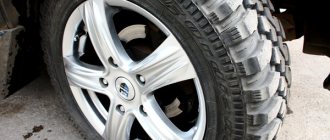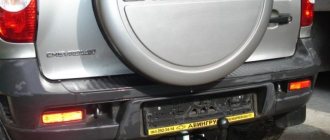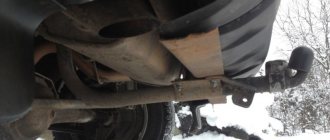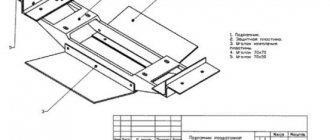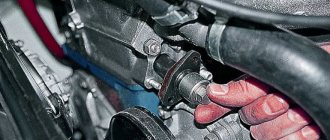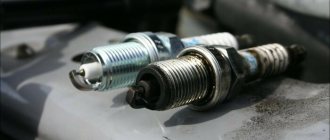Is it worth installing a self-locking differential on a Niva?
A differential is a device designed specifically to transmit the so-called torque from a car engine to its wheels using transmission elements. A free differential, installed on vehicles during assembly at the factory, cannot affect the other when one of the wheels slips. Differential locking can help achieve different wheel speeds when necessary (for example, on poor, usually dirt roads). It increases torque on one of the wheels, usually the one with the best traction. To achieve this result, a self-locking differential is used. An alternative option could be a forced blocking method. It is important to understand whether it is worth installing a self-locking differential on the Niva, what this will do for the car and how to carry out the installation of the device.
What are users saying?
As reviews indicate, it is not advisable to install a self-locking differential on a Niva in all cases. If the driver intends to constantly operate the vehicle on serious and difficult off-road conditions, installing a self-block makes sense. When driving regularly around the city or on a country road, this idea is irrelevant. The existing factory analogue copes well in such cases on its own, and it has a longer service life.
In addition, users recommend installing the mechanism themselves only if the owner has the appropriate skills and a clear understanding of the design features of the vehicle. Otherwise, use the services of a car service. The choice of the configuration of the self-block and the location of its installation depends solely on the preferences of the owner of the machine.
Source
Why do you need a self-block for Niva?
The presence of all-wheel drive in a car does not always give it the status of an all-terrain vehicle. Sometimes, due to the nature of their design, vehicles designed for off-road driving can become trapped on washed out roads. A self-locking differential is an important component of the car if the driver plans to use his Niva to drive on bad roads.
What is a self-block, or limited slip differential? This is a device that ensures wheel locking, and automatically, at the right time. It is an intermediate option between a full lock and a free differential. The self-block combines the capabilities of both of these devices.
What is forced differential locking?
It is only necessary in cases where, for example, only one of the 4 wheels will rotate. For example, when hanging horizontally, one wheel will be raised and maximum torque will be transmitted to it. In this case, all-wheel drive will be automatically disabled. Therefore, a forced differential lock is installed on the Niva. But it should only be used in off-road conditions. You can turn it on by moving the small lever forward.
The changes introduced by the American concern GM to the transfer case turned out to be quite minor. But at the same time they radically changed its structure. Compared to the old Niva, the need for an additional lever has disappeared and there are only two of them left. The modified location of the transfer case supports made it possible to reduce the vibration load on the body, thereby significantly reducing the noise level from the transmission.
Types of mechanisms
There are two main types of self-locking differentials, which include several more subtypes. The first type is devices that lock depending on the angular velocities on the vehicle axles. They can be:
The second type is mechanisms that lock depending on the torques on the axes. These include worm differentials.
There are also center and cross-axle differentials. They involve the distribution of torque between the axles and wheels, respectively. Depending on the moment of distribution attributable to the axles or wheels, symmetrical and asymmetrical types of mechanisms are distinguished. On vehicles called all-wheel drive, three types of differentials are installed at once: two of them are interwheel, and one is interaxle.
On the Niva it is possible to install electronic, mechanical (it is a conventional mechanism combined with a viscous coupling), and pneumatic differentials.
The electronic self-block has a very big advantage. To use it, just press a button. It works in automatic mode, but only when the car is traveling at a certain speed, which is below a threshold value. The system turns off when the speed exceeds the set speed.
The pneumatic differential is a mechanism mounted on two axles. The advantage is compactness. In its work it uses pneumatic systems.
The mechanical self-block is the simplest in its design; it is cheaper than pneumatic and electronic devices. The mechanism consists of two semi-axial and two spacer couplings, pins and springs. Quite a reliable design, despite its simplicity.
Characteristics and selection rules
The choice of a self-locking differential is determined by the car model, its operating conditions, driving style and many other parameters. For example, a ball differential increases steering load, which actually changes the driving style of whoever is behind the wheel. This is mainly felt when making U-turns and turns, but can lead to breakdowns of transmission components.
If you approach the choice of a self-block correctly, then you need to take into account which axle of the car the mechanism will be installed on, since the number of splines for different models is different - twenty-two or twenty-four.
The marking on the device packaging will tell you whether it can be used for a given car brand. The blocking coefficient also varies: for example, 0.5 or 0.7. These numbers show the amount of torque transmitted. What to choose is up to the driver.
In general, what are we talking about?
Here, before considering the self-block, we probably need to touch on two issues related to the movement of the car in general and the Niva in particular.
Movement in a turn
In this case, if you simply draw a picture of how the car moves, it immediately becomes clear that the wheels located closer to the center of the turn or on the inner side travel a shorter distance than the wheels moving along the outer radius. This means they move at different speeds. This will cause increased tire wear, and at high speeds – skidding.
To avoid this phenomenon, a device such as a differential is used. Its purpose is to transmit torque from one source to two different consumers, while each of them can receive a different torque, which ensures, in particular, the rotation of the wheels moving along the outer and inner turning radius at different speeds.
DIY self-block installation instructions
To install a self-locking differential on a Niva, it is not necessary to contact a car service center. It is quite possible to do this with your own hands, provided that the person has a good understanding of the structure of the car. The type of differential and its installation location are not particularly important.
First you need to decide on the place where the work will be done; it should be spacious enough. Using several jacks, you will need to lift the Niva, dismantle the wheels, then drain the engine oil from the gearbox housing into some container and remove the drive axle drive. To do this, just use a spanner to unscrew all the nuts securing the front cover to the gearbox housing, remove the cover and gasket.
Now it is necessary to reliably and efficiently carry out the operation of dismantling the axle shafts, which is very difficult to do without a special puller. The metal is clamped on rotary slots, which requires a lot of effort, which not every person has enough. Dismantling the axle shafts is carried out as follows:
Then you need to change the bearings. This will require a hydraulic press. It will help ensure that the holder fits onto the shaft, and with fairly high accuracy. To replace you need:
After the clearances in the main gear are adjusted using special washers of variable thickness, you can begin assembling the unit. Adjusting the gaps is quite difficult, and you will need special equipment, but to ensure accuracy you can use a steelyard. To work with it, wind one end of a 1 m long cord around the flange and secure the other end to the scales. By pulling the device in the winding, you will need to record the turning moment.
To ensure proper operation of the gearbox, the parts are usually sealed before the halves are assembled. In its absence, malfunctions may occur during operation, as well as failure of certain spare parts. After applying the sealant, you need to wait a while for it to harden. Then new oil should be poured into the gear housing. All sealing joints that were damaged during dismantling, as well as those that show signs of oil leakage, must be completely replaced with new ones. Now you can start assembling all the mechanisms in reverse order.
After completing all the replacement and installation of parts, you must check the operation of the devices that provide vehicle braking. Their malfunction may affect road safety.
The feasibility of such an action as differential locking on a Niva depends on why the driver needs it. If you need to move through difficult areas, you will need it. If a car enthusiast intends to drive on a normal asphalt road, then installing a self-locking differential on the Niva is hardly worth it. Which self-block to choose and where to place it depends on the driver’s preferences.
Source
Self-locking differential on Niva: is it worth installing?
Niva car is a type of off-road vehicle. This car is designed for driving on not the best sections of the road, off-road.
What is a limited slip differential?
A self-locking differential is a device based on a screw design. Increases the cross-country ability of vehicles, in particular such as Niva. When installing a differential, the car can easily overcome difficult sections of the road and terrain where driving is difficult. Therefore, installing a “self-block” on a Niva increases and improves the capabilities of this machine.
Center lock
There are devices that are designed only for off-road vehicles. They are not installed on cars for normal city driving. One of these “helpers” is the Center Differential. It distributes movement across axes. Its purpose is to transfer the rotating movement of one source to others . That is, if the rear or front wheels slip and the car cannot move, then the driving dynamics are distributed to all wheels. The operation of the center lock is based on a simple principle - the torque (rotation of the wheels) is divided between the front and rear axles . This effect makes it possible for the car to continue moving. Agree that this is a very good invention for cars - SUVs, which also includes the Niva.
Single axle locking – cross-axle
Cross-wheel locking of one axle is another function of a self-locking differential. To drive through difficult terrain, axle locking will undoubtedly be necessary. But often this is not enough. And there is a need to increase the power of the machine. It is in this case that you need to use inter-wheel locking of one axle.
The axle lock can be forced by the driver.
It can also be automatic. When one of the wheels slips
, the locking function is activated.
The principle of operation is the transmission of rotational motion exactly where the load is least .
If the “self-block” is installed on the front axle, it is possible to enable inter-wheel locking. If on the rear axle, then on the rear axle there is the same possibility. Interaxle locking switches movement from the front axle to the rear and vice versa, and interwheel locking transfers torque between the wheels on a certain axle . The inter-wheel locking can automatically turn on itself, if necessary. During normal driving, the differential operates in classic mode.
The question arises,
on which axle is it more advisable to install a self-locking differential
, on the front or on the rear?
Motorists have differing opinions on this. Some recommend the rear axle, others vice versa. If you are afraid of getting stuck on the road or problem area, especially due to adverse weather conditions, you can install a “self-block” on the front and rear axles . This will give you confidence, and if the car gets into a difficult section of the road, all wheels will work perfectly!
What types of self-locking differentials are there for the Niva?
A self-locking differential can be selected for any make of car. They are available for both domestic and foreign cars.
If we objectively characterize the types and principles of operation of differentials, then they can be divided into three types :
1. Locking differential
, which will turn on and occur when the movement accelerates.
2. Self-locking differential
, which functions when braking and accelerating the car.
3. Something in between the first and second types. When slowing down, there will be a smoother operating process.
Also defining names: gerotor differential, differential that is sensitive to the difference in rotational torques of movement, friction differential.
Perhaps, of these three types, the least desirable is friction . Why is it not as good as other types? Inside it, friction discs are located on the axle shafts. Fuel consumption when using it increases slightly, and the service life of the friction discs is short. Among the manufacturing companies that manufacture these devices, there are both foreign and domestic manufacturers. The choice depends on your preferences, car brand and characteristics.
Advantages and disadvantages of installation
The self-locking differential is a separate independent design. It is, of course, recommended that it be installed at a car service center. But if you have an understanding and knowledge of the device, the work and the car as a whole, then you can do the installation yourself.
Important points should be taken into account, including adjusting parts , determining marks and gaps, which not everyone can do accurately. Therefore, a qualified automotive service specialist can install the “self-block” at a professional level. It will be much more reliable than if you did this work yourself.
Owner reviews
From numerous reviews from motorists, you can always find important aspects. For example, regarding the installation issue - is it possible to install a differential on the front axle, or only on the rear? Regarding Niva cars, it can be installed on both axles .
The increase in cross-country ability from the front block is greater than from the rear one, since the front wheels have more load and are controlled. A helical self-locking differential is more reliable. For the Niva car, it is recommended to use not only reduced blocking , but also add center blocking. Thanks to this equipment, the car can cope even with ice and various types of severe off-road conditions.
